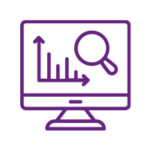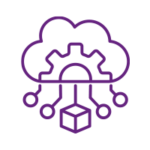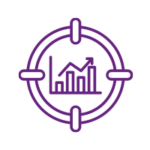Geospatial Data
What is geospatial data?
Geospatial data, also known as spatial data or geographic information, is the data or information that identifies the geographic location and characteristics of natural or constructed features, and boundaries on the earth. This data may be represented as points, lines, polygons and more complex structures. Essentially, it tells us about the location and shapes of geographical features and the relationships between them.
Examples include everything from the coordinates (latitude and longitude) of a single point on the earth, to more complex data such as a country’s transportation network or the locations and boundaries of all the buildings in a city.
Using geospatial data
Geospatial data can be used in a variety of ways depending on the goals of the user. It is typically loaded into a Geographic Information System (GIS), which is software that allows users to visualise, manipulate, and analyse geospatial data.
For instance, if a user wanted to analyse traffic patterns in a city, they might load geospatial data on roads, intersections, and traffic signals into a GIS and use it to create a map or model of traffic flow. This could help identify problem areas and inform decisions about where to build new roads or how to better manage traffic.
This data can also be used in predictive modelling, such as using past weather data and terrain information to predict where wildfires are likely to occur, or using data on population distribution and hospital locations to plan where new health care facilities should be built.
The importance of geospatial data
In an increasingly interconnected and data-driven world, understanding where things are and how they are related is critical for a wide range of decision-making processes. This is why the importance of geospatial data cannot be overstated.
It is the basis for many important applications, including urban planning, disaster management, navigation, environmental management, public health, and many more. It helps us understand our world better, make informed decisions, and solve complex problems.
Who uses it?
The users of geospatial data span a broad spectrum, from individual citizens to large corporations and governments. Here are a few examples with information about how they apply this data:
-
Urban Planners:
They use it to understand the current urban infrastructure and plan for future developments, including where to build new housing or transportation systems. -
Environmental Scientists:
They use this data to study and monitor changes in the environment, such as deforestation, climate change, or water pollution. -
Public Health Officials:
It can be used to track the spread of diseases, plan for health services, and analyse health outcomes in relation to environmental factors. -
Retailers:
Businesses use this data for site selection, market analysis, logistics, and delivery routes. -
Government Agencies:
They use it for a wide range of purposes, from managing public lands to conducting censuses. -
General Public:
Everyday people use this data for navigation, finding places of interest, and understanding their local environment.
Geospatial solutions by Nordend
Geospatial data is a critical resource in our modern world. It helps us understand our environment, plan for the future, and make informed decisions that can impact everything from daily life to global initiatives.
At Nordend, we offer a broad range of comprehensive geospatial solutions. With a strong foundation in geospatial technology and data analysis, we provide the insights and understanding you need to make informed decisions, manage your resources effectively, and gain a competitive edge.
Our team of skilled geospatial analysts, GIS experts, and data scientists work with you to understand your specific needs and deliver tailor-made, practical solutions.
Geospatial Data Analysis
Our team uses advanced tools and techniques to analyse your geospatial data, revealing patterns, trends, and relationships that can drive your decision-making process. Whether you’re looking to optimise your delivery routes, analyse traffic patterns, or study environmental changes, our data analysis services provide the insights you need.
GIS Solutions
We provide end-to-end Geographic Information System (GIS) solutions, from data integration to analysis and visualisation. Our GIS experts help you turn complex geospatial data into easy-to-understand maps and visualisations, enabling you to see the big picture and make informed decisions.
Predictive Modelling
Utilising your historical data, we can create predictive models to foresee future trends or outcomes. From predicting wildfire occurrences to planning health care facilities based on population distribution, our predictive modelling services help you prepare for the future.
Environmental Services
We provide a range of environmental services, including environmental impact assessments, habitat modelling, and pollution tracking. Our team uses geospatial data to help you understand and mitigate your impact on the environment.
Retail Site Selection & Market Analysis
Our retail solutions include site selection, market analysis, and logistics optimisation. We use geospatial data to help you understand the market dynamics, find the best locations for your business, and optimise your supply chain.

Geospatial Data Analysis
Our team uses advanced tools and techniques to analyse your geospatial data, revealing patterns, trends, and relationships that can drive your decision-making process. Whether you’re looking to optimise your delivery routes, analyse traffic patterns, or study environmental changes, our data analysis services provide the insights you need.

GIS Solutions
We provide end-to-end Geographic Information System (GIS) solutions, from data integration to analysis and visualisation. Our GIS experts help you turn complex geospatial data into easy-to-understand maps and visualisations, enabling you to see the big picture and make informed decisions.

Predictive Modelling
Utilising your historical data, we can create predictive models to foresee future trends or outcomes. From predicting wildfire occurrences to planning health care facilities based on population distribution, our predictive modelling services help you prepare for the future.

Environmental Services
We provide a range of environmental services, including environmental impact assessments, habitat modelling, and pollution tracking. Our team uses geospatial data to help you understand and mitigate your impact on the environment.

Retail Site Selection & Market Analysis
Our retail solutions include site selection, market analysis, and logistics optimisation. We use geospatial data to help you understand the market dynamics, find the best locations for your business, and optimise your supply chain.
Why choose Nordend?
At Nordend, we are dedicated to providing our clients with practical, effective solutions that meet their unique needs. We understand that every client is unique, and we strive to provide a personalised service that takes into account your specific goals, challenges, and resources.
Our team is committed to staying on the cutting edge of geospatial technology, ensuring that we can always offer you the most up-to-date and effective solutions.
Take the first step towards leveraging the power of geospatial data today. Contact us to learn more about our services and how we can help you achieve your goals.


